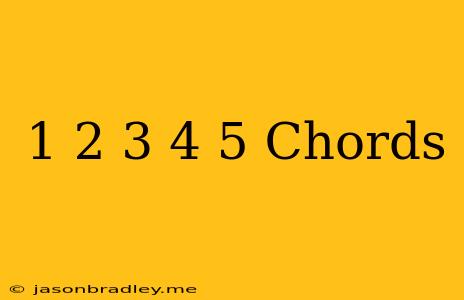Mastering the 1 2 3 4 5 Chords: Your Journey to Musical Mastery
The 1 2 3 4 5 chords, also known as the I, ii, iii, IV, and V chords, form the backbone of countless songs across various genres. Understanding these chords and their relationships is crucial for any musician, whether you're a beginner or a seasoned professional. This guide will walk you through the basics of these chords, their uses, and how to build them on different instruments.
What are the 1 2 3 4 5 Chords?
These chords are named based on their relationship to the root note of a given key. The I chord is the tonic chord, which is the foundation of the key. The other chords are built from the corresponding degrees of the major scale, giving us:
- I chord: Built on the root note of the scale
- ii chord: Built on the second note of the scale (minor chord)
- iii chord: Built on the third note of the scale (minor chord)
- IV chord: Built on the fourth note of the scale (major chord)
- V chord: Built on the fifth note of the scale (major chord)
For example, in the key of C major:
- I chord: C major (C-E-G)
- ii chord: Dm (D-F-A)
- iii chord: Em (E-G-B)
- IV chord: F major (F-A-C)
- V chord: G major (G-B-D)
Why are They So Important?
The 1 2 3 4 5 chords form a progression that is inherently satisfying to the ear. This progression is found in countless popular songs across different genres, and understanding it allows you to:
- Create your own melodies and harmonies: You can experiment with these chords and their inversions to come up with unique and catchy progressions.
- Improvise and play along with songs: Once you understand these chords, you can easily play along with existing songs and even create your own improvisations over them.
- Understand the structure of music: These chords form the foundation of most music theory concepts, allowing you to learn more complex harmonic structures as you progress.
Building the Chords
Guitar:
- I chord: Play the root note, major third, and perfect fifth of the key (e.g., C-E-G for C major).
- ii chord: Play the root note, minor third, and perfect fifth (e.g., D-F-A for Dm).
- iii chord: Play the root note, minor third, and perfect fifth (e.g., E-G-B for Em).
- IV chord: Play the root note, major third, and perfect fifth (e.g., F-A-C for F major).
- V chord: Play the root note, major third, and perfect fifth (e.g., G-B-D for G major).
Piano:
- I chord: Play the root note, major third, and perfect fifth (e.g., C-E-G for C major).
- ii chord: Play the root note, minor third, and perfect fifth (e.g., D-F-A for Dm).
- iii chord: Play the root note, minor third, and perfect fifth (e.g., E-G-B for Em).
- IV chord: Play the root note, major third, and perfect fifth (e.g., F-A-C for F major).
- V chord: Play the root note, major third, and perfect fifth (e.g., G-B-D for G major).
Conclusion
Understanding the 1 2 3 4 5 chords is a fundamental step in your musical journey. Whether you're a beginner or an experienced musician, mastering these chords will open doors to a world of possibilities in creating and playing music. With practice and exploration, you can unlock the magic of these essential chords and take your musical skills to the next level.
